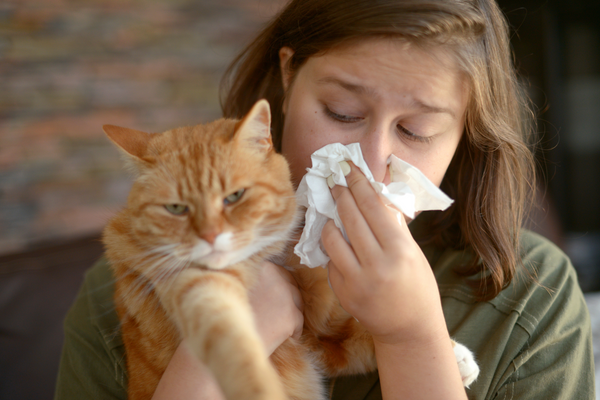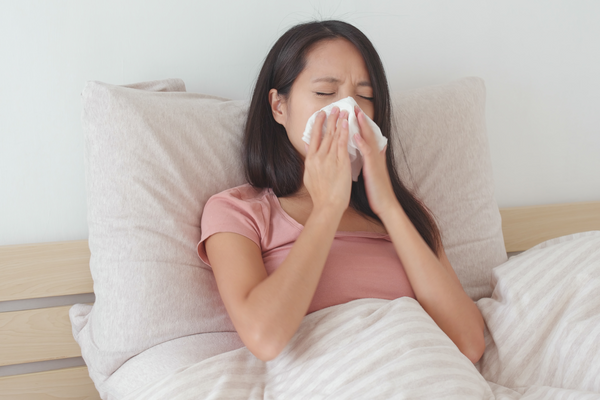What is a Dust Mite Allergy?

Dust mites are tiny arachnids that live in nearly every home on Earth. They are too small to be seen by the naked eye and measure only about one-quarter to one-third of a millimeter. That is smaller than the period at the end of this sentence. If you have allergies or asthma, these microscopic creatures could be wreaking havoc on your well-being. Dust mites are the most common trigger of year-round allergies and asthma. Pets can also have allergic reactions to dust mites.
Many people assume that a dust mite allergy means they’re sensitive to the dust mites themselves. But in reality, it’s the dust mites’ feces, shed particles, and decaying body parts that cause allergic reactions. It’s important to note that a dust mite allergy is not a sign of a dirty house! There are 13 species of dust mites, and all of them are well-adapted to the environment inside your home. Dust mites mainly survive off the tiny flakes of skin that humans and pets shed every day. These shed skin flakes work their way down into household items like bedding, upholstered furniture, carpets, and stuffed toys.
According to the Asthma and Allergy Foundation of America (AAFA), dust mite debris, including their body parts and feces, can become airborne and degrade indoor air quality. Dust mite containment and prevention are vital steps to improve your overall indoor air quality and reduce (or prevent) your allergy symptoms.
What Are the Common Symptoms of a Dust Mite Allergy?
Dust mite allergies can range from mild to severe. A mild case may cause sneezing, itchy, watery eyes, and an occasional runny or stuffy nose. The allergic condition is ongoing or chronic in severe cases, resulting in persistent sneezing, cough, congestion, headaches, wheezing, facial pressure, tightness in the chest, eczema (atopic dermatitis), or severe asthma attacks. People with asthma who are sensitive to dust mite allergens face an increased risk of flare-ups or asthma attacks. All of these symptoms can also have a detrimental effect on sleep, causing allergy sufferers to wake up several times during the night.
Is There a Cure for Dust Mite Allergies?
There is no cure for dust mite allergies. However, there are several ways to help manage and prevent allergy symptoms, including controlling indoor humidity and reducing dust mites in your home (more on that below). Medications and other treatments can also be helpful for symptom management.
If you experience year-round allergy symptoms, it’s worth a trip to your allergist to determine whether or not you’re allergic to dust mites. Need help finding a certified allergist? Check out this search tool that the American College of Allergy, Asthma, & Immunology (ACAAI) offers and find a certified allergist near you.
Do Mattress and Pillow Covers Help Dust Mite Allergies?
According to recent clinical trials, zippered dust-proof mattress and pillow covers may not help much with dust mite allergies. These 24 clinical trials, published in the journal Annals of Allergy, Asthma, and Immunology, found that the covers reduced house mite dust exposure by 20%. However, this reduced impact was not statistically significant in terms of house dust mite sensitization or effectiveness on symptoms such as wheezing, asthma, runny nose, or atopic dermatitis.
"Based on this analysis which combines data from many different studies, there doesn't seem to be any benefit to using dust mite covers to prevent allergic disease or to prevent symptoms," lead author Whitney Arroyave from the Tulane University School of Public Health and Tropical Medicine in New Orleans, told Reuters Health.
The key takeaway from the research is that mattress covers and pillow covers can be helpful to reduce exposure to dust mites, but they should be a part of a comprehensive treatment plan.
How to Reduce Dust Mites in Your Home
Throughout its lifetime, a single dust mite can produce up to 200 times its body weight in waste, which, if left unaddressed, can accumulate extraordinarily quickly. Gross!
Although it’s impossible to eliminate dust mites from your home, there are several methods you can use to drastically reduce their numbers and neutralize their threat. Consider these tips for managing dust mite allergens:
Reduce Clutter
Decluttering and organizing your home is not only aesthetically pleasing; it also gives dust fewer places to settle and makes cleaning – and eliminating dust mite populations – easier.
Wash Your Bedding Weekly
Wash your sheets, pillowcases, and blankets with our Anti-Allergen Laundry Detergent every week. This practice accomplishes two goals: killing dust mites and removing their allergens.
Bed pillows should also be washed regularly (and replaced every two years) to remove mites and eliminate the allergens.
Lower the Indoor Temperature & Humidity
Dust mites thrive in warm, humid environments, which means you may be battling the overall humidity in your home depending on your local climate. To help make your home less appealing to mites, set your thermostat to 70°F or less and monitor the humidity to keep it below 50%. A combination of fans, air conditioning, and dehumidifiers can help to control the moisture inside your home.
Groom Your Pets Regularly
Regular bathing can help prevent allergy triggers from allergens caught in your pet’s fur. Our hypoallergenic Anti-Allergen Pet Shampoo eliminates allergens from dust mites and pet dander from your furry companion’s coat. The shampoo helps pets as well as owners with allergies.
Related: Dust Mite Allergies in Dogs: How to Reduce Allergens & Give Your Dog Relief
Keep Your Mattress Clean & Healthy
To dust mites, mattresses are paradise. You breathe, sweat, and shed skin cells in your bed every night – unintentionally providing an ideal source of humidity and food for dust mites. In fact, a typical mattress may contain anywhere from 100,000 to 10 million dust mites. Before you toss your mattress, take heart! You can eliminate dust mites and their allergens with a deep cleaning.
As you’re cleaning, keep in mind that these pesky little critters have tiny barbs on their legs that help them cling onto fibers, making them nearly impossible to remove by routine vacuuming, so take your time and do a thorough job when you’re cleaning your mattress. Hot water extraction with a “rinse & vac” system works well and has the added benefit of reducing more allergens, as dust mite allergens are water-soluble. Adding Dustmite & Flea Control to the hot water vacuum will help to keep dust mites from coming back.
With dust mites eliminated, they can no longer produce particles that contribute to your symptoms. Just make sure that you allow your mattress to thoroughly dry after cleaning. Remember, dust mites thrive in places with high humidity. Lowering the air conditioning and using fans will help speed up the drying time.
Up Your Cleaning Game
Avoid dry dusting methods, and instead, use damp cleaning cloths and our Anti-Allergen Solution to neutralize dust mite allergens on contact while you’re cleaning. The fragrance-free, stain-free solution works on hard and soft surfaces.
Vacuum Carpets & Rugs
If you suffer from dust mite allergies, wear a dust mask and open the windows to ventilate when you vacuum or, if possible, ask someone else to do it for you. Generally, carpets and rugs should be cleaned twice weekly or daily if you have a crawling baby or a pet that sheds. To actually capture dust (as well as pet dander and other airborne allergens), it’s essential to use a vacuum with a sealed high-efficiency particulate air (HEPA) filter. HEPA filters work by trapping tiny particles in the fine mesh, including dust, pollen, and even tobacco smoke. After thoroughly vacuuming, spray carpets and more oversized rugs with Anti-Allergen Solution to eliminate dust mites and allergens. Toss washable throw rugs in the water with the Anti-Allergen Laundry Detergent.
Have questions about cat dander or other common indoor allergens? We have answers! The Ecology Works has been helping people with allergies and asthma since 1993. We can help you select the products you need to live a better, allergen-free life. Please feel free to Contact Us or message us on Facebook. No question is too small! We’re here to help.




